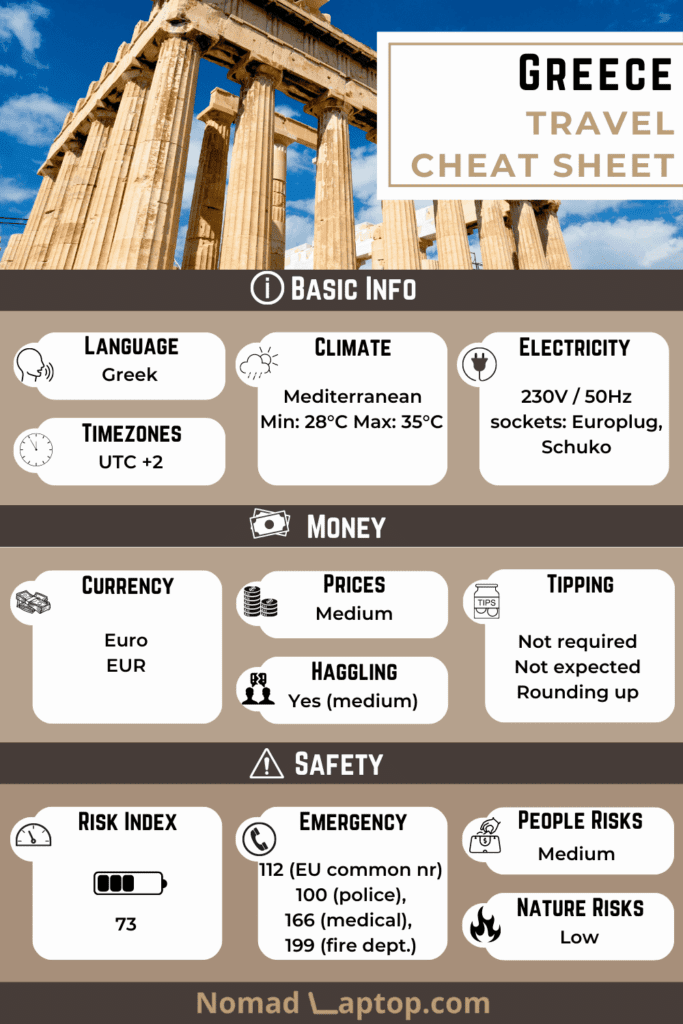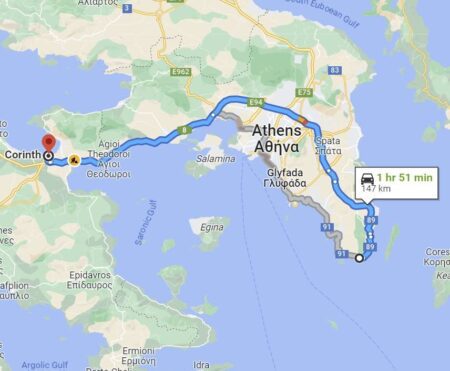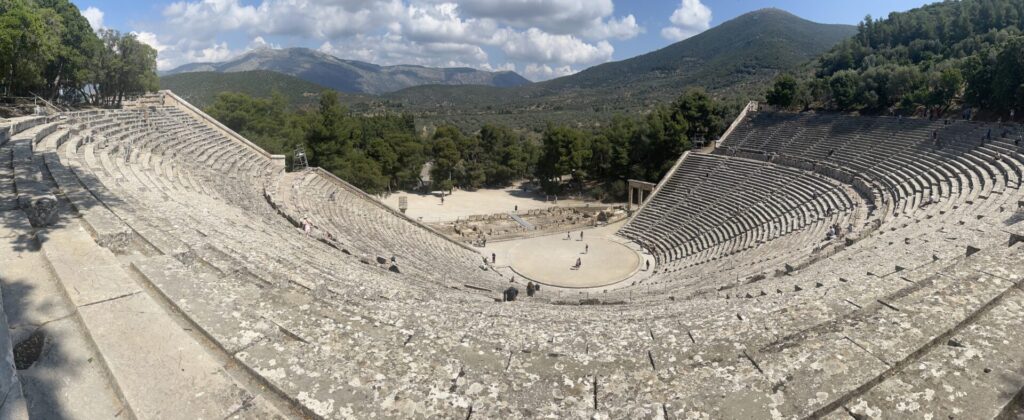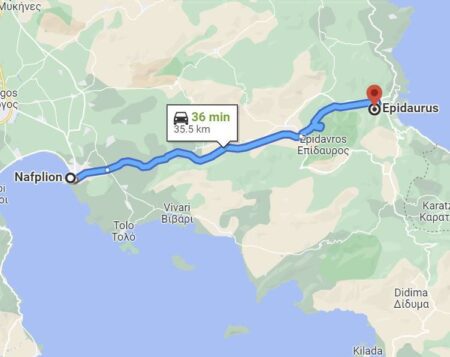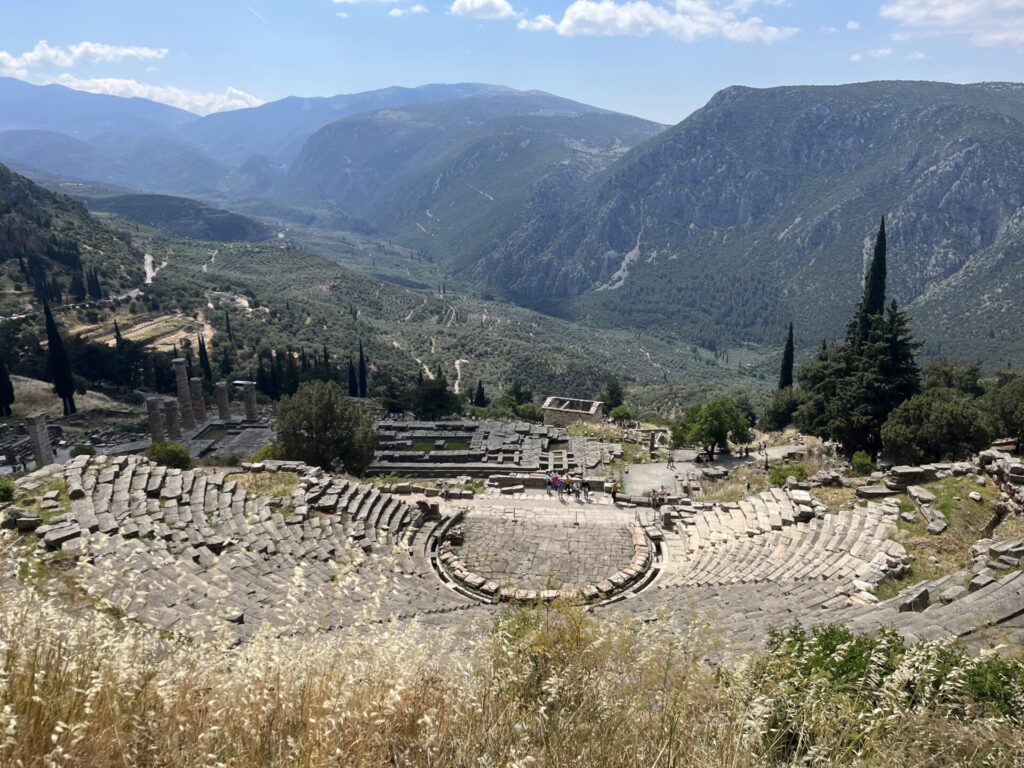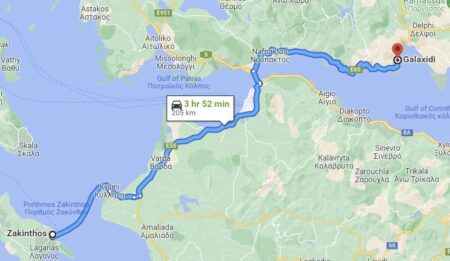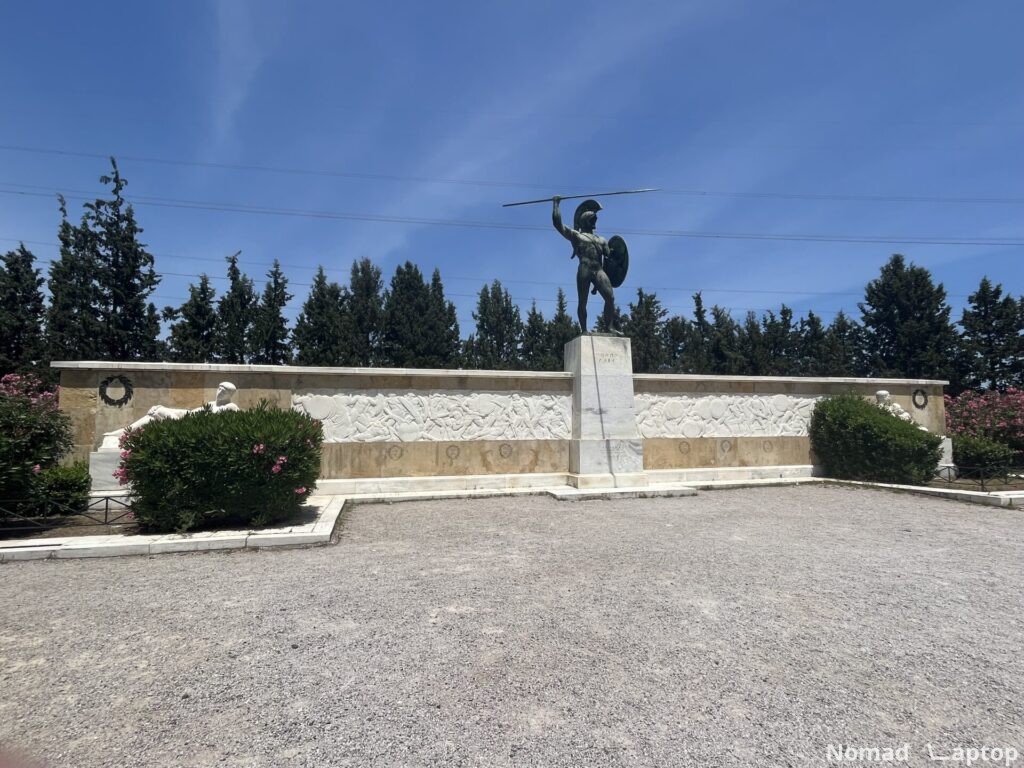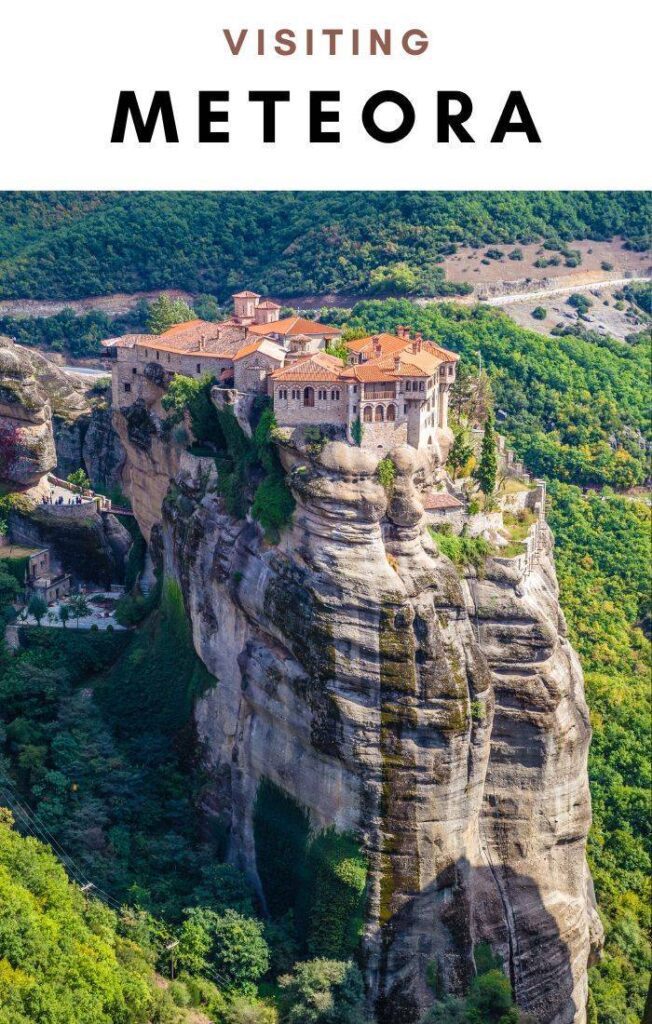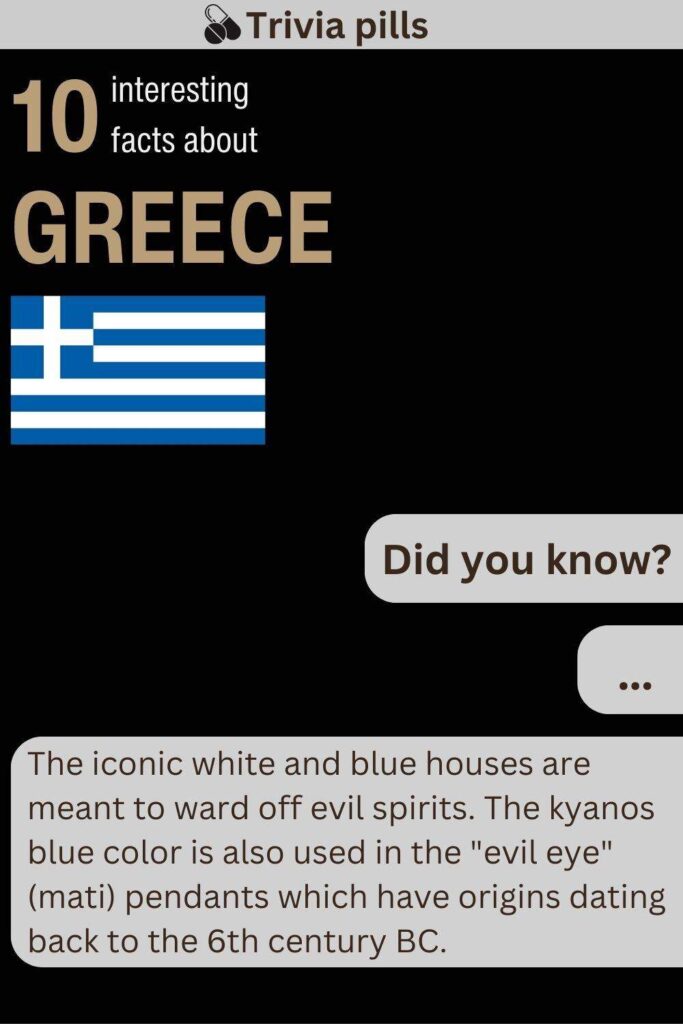An epic road trip takes on a new meaning when done through mainland Greece and the Pelopponese when immersed in the cradle of western civilization. The temples of the gods in Athens, Sounion, and Olympia. The ancient cities of Mycenae and Delphi. The Kyanos blue waters on the island of Zakynthos. The otherworldly monoliths and monasteries in Meteora. The foothills of Mount Olympus at Litochoro, and the coastal towns of Nafplion, Galaxidi, and Thessaloniki. Nothing can quite stand up to the overload of beauty of driving among thousands of olive trees, kissed by the sun, caressed by the sea breeze, and stopping on the rugged coast to look at a Greek sunset.
I have visited Greece many times since I was a child, and I think that what initially made me fall in love with road trips was this country. I still remember when I was driving in Crete one late afternoon and stopped the car on the side of the road, climbed down the rugged coastline, and took a dip in the refreshing waters. When I came back, I stood there admiring the fiery sun setting into the sea.
Greece is a major tourist destination, and from a tourism perspective, it seems that the country is simply perfect. The rugged scenery, the whitewashed villages, and the unbeatable sunsets all contribute to creating some of the most stunning landscapes in the world. The delicious cuisine, the ancient history and monuments, the friendly people, and the sun-kissed beaches provide a never-ending supply of visitor opportunities.
This road trip was done in early June, and I followed almost exactly the footsteps of a road trip that I did when I was 10 years old. It is heavily based on seeing some of the most important archaeological sites and Greek ruins, with a side tour on the Ionian island of Zakynthos to take in some of the island’s beauty, and a brief stop in coastal cities and small towns to absorb the beautiful atmosphere and delicious food.
So I repeat once again, there isn’t anything quite like sitting in a Taverna and eating delicious seafood surrounded by the sound of cicadas while watching the mystical sunset in Greece.
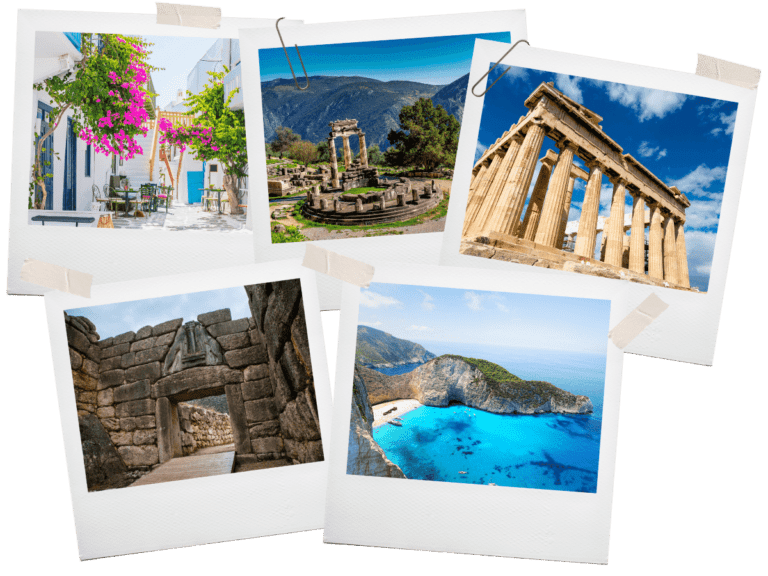
What to expect
- Scenery: Infinite landscapes of olive trees, dotted by purple bougainvilleas and yellow gorses. Iconic white and blue houses perched on the rugged coastal cliffs. The scenery in Greece is one of a kind
- History: Also here, there is not much to say except that it is the pinnacle. In few other places can you feel ancient legends and mythological Gods talking to you when visiting the ruins or landmarks
Tips & Impressions
- Try to get early to ultra-popular sites such as the Acropolis in Athens or the monasteries in Meteora. Not only will you have the place all to yourself but you will also escape from the higher heat during the day, where you can instead hop into a cafe and experience the town life while enjoying a cold coffee.
- Get car insurance for your rental. My windshield was broken this time, and other times (on islands), I had smaller accidents with tourists on scooters crashing into me. The narrow streets in small towns and winding mountainous roads, many of which are dirt roads, make it a place where driving can be a bit harder than elsewhere.
Overview
This was yet another road trip where I crammed too many destinations in too short a time. However, having visited each location already once, the 1300 km itinerary in two weeks was doable for me, but I wouldn’t recommend it to someone else and would advise taking more time. There is so much to see and, especially, so much to enjoy that it is better to take your time and do it with a more laid-back approach.
See the Itinerary below for a detailed breakdown of every stop.
Country Info
- Language: Greek is the official language.
- Population: 1.1 million (2019 est.)
- Ethnic Groups: Greek 98%, other 2%
- Religions: Greek Orthodox 98%, Muslim 1.3%, other 0.7%
- Political System: parliamentary republic; monarchy rejected by referendum, 8 December 1974
- Currency: Euro (EUR).
- Credit Cards: Cards are widely accepted, and ATMs are widely distributed. Payment preference though, is cash
- Electricity: socket types: Europlug, Schuko, 230 volt / 50 hertz
- Tipping Customs: 10-15% in restaurants and bars
- Haggling Culture: Common in markets and tourist areas
Check the Greece page for more country-general information
Trivia pill
With more than 7000 years of history and widely considered the cradle of Western civilization, Greece oozes antiquity and the pervasive feeling of being where it all began.
From the first democracies and political systems that have influenced the world for millennia to the origins of philosophy and math, Hippocratic oaths, and the advances in modern medicine The first Olympic games at ancient Olympia were the first “marathon” by the poor Pheilippides, the messenger who ran 40 kilometers to announce the victory at the battle of Marathon. The first computer, in the form of the “secret” and obtuse ancient artifact of the Antikythera mechanism, was used for astronomical calculations.
The country hosts 18 Unesco sites and has more archaeological museums than any other country in the world, and at many sites, it is forbidden to wear high heels to avoid damaging the monuments and ruins.
Safety
- Safety: Greece is very safe to visit and welcoming towards tourists. Being a highly sought-after tourism destination, be wary of the usual scams and pickpocketing risks in larger cities.
- Natural risks: There are no major natural risks in Greece.
- Emergencies numbers: 112 (European common emergency service), 100 (police), 166 (emergency medical services), 199 (fire department)
Getting around
- Driving basics: Driving is on the right side of the road with the steering wheel on the left. All common driving requirements of developed countries are followed i.e. mandatory seatbelts and illegal to drive under the influence (limit at 0.05%).
- Roads: Roads are generally in good shape. Highways are in pristine condition and also the state roads are often very well maintained. On islands, though this is different, and even in the large and popular Zakynthos, narrow dirt roads are common.
- Safety: The roads might be in good shape but there are some risks to driving in Greece and it is better to get car insurance. Because of the narrow roads, unpredictable tourist motorcycles and quadbikes on the islands, parking on the side of the roads, and taking ferries where cars are packed, it is not uncommon to have minor accidents or bumps.
- Speed limits: 50kms/h in urban areas and 90-110kms/h outside urban areas and 130kms/h on highways.
- Driving etiquette: You will always see people waving hand gestures and thanking you or apologizing for entering your lane for example. Because of the nimble and reactive nature of driving and different vehicles, it is common to find yourself both being honked at because you’re letting everybody pass as well as being cut off or seeing vehicles skittering into your lane.
- Driving quirks: Nothing major but there is a general lax approach to traffic. On islands, it is almost impossible to see people wearing a helmet while on two wheels. Outside of cities, parking is done following the “I stop now on the side of the road” approach
Check the Driving in Greece page for more driving tips and information

Weather
Greece has a Mediterranean climate with mild and wet winters and hot and dry summers. In the coastal areas, temperatures in the summer are generally moderate, while towards the hinterland, they can become much more extreme. Rainfall is higher during the winter months and higher in the interior mountains compared to the coastal areas. The northern parts of Greece tend to be more temperate, while temperatures in the south are typically hotter. Snowfall is most common in the northern and mountainous parts of the country.
During my visit in June, the weather was perfect. Being at the beginning of the tourism season the crowds were few, the weather was warm but not too hot. I was off just by a few weeks and the water temperature was slightly too cold but still enjoyable.
Flora & Fauna
On a road trip through Greece, the flora you will encounter are shrubs, wildflowers, and what seems to be an infinite number of olive trees. Also, pine trees are extremely common and the occasional purple bougainvillea or yellow gorse will light up the scenery.
Regarding wildlife, you may encounter foxes, hedgehogs, wild boars, and badgers, although more probably you will find cats and herds of sheep and goats crossing the road.
Small birds can be heard chirping everywhere (if their sound can overcome the deafening chorus of cicadas) and there is abundant marine life in the Greek waters.
Trivia pill
According to Greek mythology, the goddess Athena gave the first olive tree to Athens before it spread to the rest of Greece. As such olive trees were considered gifts from the Gods.
Today Greece is the third largest producer of olives and one of the largest producers of olive oil with more than 430,000 tons produced annually.
The country has the largest consumption and use of olive oil in the world with women even using it as skin care.
Itinerary
Trip Stops
Athens
Αθήνα – Athína
About
Athens is the capital of Greece and one of the world’s oldest cities, with a recorded history spanning over 3,400 years. It is widely referred to as the cradle of Western civilization and the birthplace of democracy, being the host of classical Athens, comprising the Golden Age of Greek civilization. Today, Athens stands as a modern metropolis characterized by a vibrant cultural life and numerous historical sights, monuments, and archaeological sites. The city is home to a number of renowned universities, museums, and theaters and is host to various international events and activities. Additionally, Athens has a thriving nightlife scene, making it a popular destination for both tourists and locals alike. With its modern skyline, stunning sunsets, charming coastal spots, and quintessential archaeological and historical history, Athens offers an experience like no other city.
For more info on Athens check out this article

Trivia pill
Athens is Europe’s oldest capital and its origins date back to more than 3400 years ago but has been inhabited continuously for 7000 years. It eventually became the most powerful polis/city-state in ancient times with one of the first and most developed forms of democracy.
Its name comes from the patron goddess Athena, who, according to mythology, won the competition against her brother Poseidon, on which God would have been the city guardian, by gifting the incredibly important olive tree to the city’s citizens.
Athens has more theatres (which itself is a Greek word) than any other city in the world.
Towering over the capital, the Acropolis (“highest point”) hosts the Parthenon, one of the most recognizable temples in the world and widely considered one of the most advanced forms of ancient architecture and artistic proportions. It almost became one of the “New 7 Wonders of the World” (but Mexico’s Chichén Itzá made it to the list, and don’t even get me started on Christ the Redeemer). Throughout its history, the Parthenon has been turned into a Christian church, a mosque, had its marbles stolen, and was even blown up when Greece was under Ottoman rule.
Sounion
Aκρωτήριο Σούνιο – Akrotírio Soúnio
About
Sounion is a cape on the east coast of the Attica peninsula of Greece, located 71 km south of Athens. It is renowned for the ruins of the ancient Temple of Poseidon, brother of Hades and Zeus and god of the sea in Greek mythology. The temple was built in the fifth century BC and is famous for being the site of some of the most stunning views in the world, offering views of the Aegean Sea on one side and the Saronic Gulf on the other. The area around Sounion is also a popular destination for water sports, windsurfing, and sailing.
Seeing a sunset at Sounion can only be described as a peak experience and the sun rays passing through the columns of the temple of Poseidon as it plunges into the calm waters on the horizon is certain to create a memorable experience that lasts for years.
Corinth
Κόρινθος – Kórinthos,
About
Corinth is an incredibly ancient city that was established in the late Bronze Age. It was a major city of the Roman Empire and a center of commerce. The city is home to the ancient Temple of Apollo and other archaeological sites, such as the Temple of Octavian and the Acrocorinth citadel. Corinth is also known for its numerous monuments and ruins, which reflect its strategic military importance in the ancient world. Today, it is the capital of the Corinthia region and a popular tourist destination. It is also the gateway to the Peloponnese, an area famous for its stunning scenery and numerous historical ruins.
Mycenae
Μυκήνη
About
Mycenae was an ancient city located in the Peloponnese region of southern Greece that is believed to be the center of the Mycenaean civilization, which flourished from 1600 to 1100 BCE. Mycenae was an important center of trade and commerce, and its influence was felt throughout the Mediterranean area during this period. The city was said to have been founded by Perseus, the legendary Greek hero, and it is surrounded by imposing cyclopean walls. These walls still stand to this day as a relic of the city’s proud past. Within the city, there are several palatial Greek buildings, including two large gates, the Lion’s Gate and the Portico of Hades, built in the 13th century BCE. The city was home to many important historical figures, including Agamemnon, a legendary king who led the armies of Greece against Troy. It is also known to have been a refuge for Homeric heroes during the Trojan War, and it was also the model for the legendary city of Troy. Mycenae would later be occupied by the Dorian Greeks starting in the 12th century and remain under their control for centuries until it fell to the Romans in 146 BCE. Today, Mycenae continues to be an important archaeological site and one of the most fascinating historical locations in Greece. Its ancient stones and ruins have a great deal of significance for understanding the Bronze Age and the civilization that flourished there.
Nafplion
Ναύπλιο
About
Nafplion is a historic city located in the southeast Peloponnese region of Greece. It is the capital of the prefecture of Argolis and is a popular tourist attraction due to its beautiful scenery, vibrant culture, and fascinating history. The city was initially settled in the 16th century and was the first capital of the modern Greek state from 1828 to 1834. Later on in history, it was occupied by Italy and served as the capital of the short-lived Greek puppet state during the German occupation of Greece in World War II. Today, Nafplion is a charming and vibrant destination and a great place to experience Mediterranean charm and local culture. The city is also known for its delicious cuisine, especially fresh seafood and desserts. The culture is full of rich music, art, and literature. Nafplion holds a variety of attractions, including an archaeological museum, outdoor markets, and several monuments and historic sites. One of the most popular attractions is the Palamidi Castle, which sits atop a steep hill overlooking the city. The city is also popular for its beaches, which line the Gulf of Argolis and serve as perfect spots for swimming and sunbathing.
Epidaurus
Ἐπίδαυρος
About
Epidaurus is an ancient Greek city that was the sanctuary of Asclepius, the Greek god of healing. The city is one of the most important and impressive archaeological sites in Greece, and the ruins at Epidaurus include several monuments and buildings from the 4th century BC and later, most notably the ancient theater, which is one of the best-preserved theaters in the world. This theater is still used today to host performances of ancient Greek plays during the Epidaurus Festival. This ancient site is listed as a UNESCO World Heritage Site as it is an exceptional testimony to the ancient Greek culture and civilization.
Olympia
Ολυμπία
About
Nestled along the Ionian Sea on the Peloponnese peninsula, Olympia, Greece, is world-renowned for its ancient ruins that still exist today and served as the inspiration for the modern-day Olympic Games. Olympia is an ideal destination for history and culture lovers alike. The vast archaeological site of Olympia will take you back in time, allowing you to explore the remains of the heyday of the Ancient Games and learn more about the lives of its people and their ceremonies. Spend some time exploring the Temple of Zeus, the Temple of Hera, and the Gymnasium. Walk to the ancient stadium and imagine the cheers of the thousands of onlookers. Also located in Olympia is the Archaeological Museum, where you can view archives of more than 3,000 ancient Greek artifacts. Not only can you explore the archaeological site, but you can also visit Olympia’s modern town and uncover the history, scenery, and local life within its cobbled courtyard. Relive history in Olympia and explore what drew ancient Greeks to its grounds for centuries. Whether it’s visiting its many religious and cultural sites or simply enjoying the Mediterranean sun and its ocean breezes, Olympia’s charm is undeniable.
Zakynthos
Ζάκυνθος – Zakynthos
About
Zakynthos is an island in the Ionian Sea, situated off the west coast of Greece. It stretches over a total area of 406 square kilometers and is known for its vast beauty, wonderful beaches, picturesque villages, and unique culture. It is the 6th largest Greek island and is home to over 40,000 individuals. The beaches of Zakynthos are among the most beautiful in Europe, with some of the most popular being Navagio Beach (Shipwreck Beach), Gerakas Beach, Banana Beach, Laganas Beach, Agios Nikolaos Beach, and Porto Zoro Beach. Zakynthos is a paradise for nature lovers, as it boasts a national park and a marine park. Patches of lush green vegetation adorn the mainland, while crystal-clear waters surround the island.
For more info on Zakynthos check out this article on my relaxing stay.
Drive
Reaching Zakynthos by car requires a ferry to be taken at the port of Killini. From Olympia, it is an overall ~4h trip with about 1 hour ferry crossing.
Trivia pill
The blue color (kyanos) is believed to protect against evil spirits. It can be found in the iconic white houses with blue doors and roofs and is also on the famous pendants used to ward off the “evil eye” (mati). The mati pendants have origins dating back to the 6th century BC.
Speaking of superstitions, ancient Greeks also did not eat beans as they believed that the grains contained the souls of dead people.
Delphi
Δελφοί
About
Delphi is one of the most important ancient sites in Greece, as it was a central religious destination and was believed to be the center of the Earth’s spiritual and cosmic energy. Delphi, in fact, was known as the “Navel of the World” in antiquity. It was the site of the Oracle of Apollo, whom many would visit to receive prophecies or wisdom from the gods. Today, its monuments are etched into the rugged surrounding landscape, and visiting the archaeological site is an unforgettable experience.
Thermopylae
Θερμοπύλαι
About
Thermopylae is the site of an ancient battle that occurred in 480 BC, where a small group of Spartan soldiers (the famous “300”), led by King Leonidas, fought against the massive Persian army. Many tales have since been told of the bravery and courage of the Spartan soldiers in their attempt to prevent the invasion of Greece by the Persian army. The battle of Thermopylae is remembered as a symbol of bravery and courage in the face of insurmountable odds.
Thermopylae is also a famous location as the nearby thermal waters springing from the underground rocks were believed to be one of the entrances to Hades – the mythological Greek underworld. Other legends state that Hercules bathed in the waters of Thermopylae after he had defeated the Hydra, and the washed-off blood of the monster poisoned the waters.
Meteora
Μετέωρα
About
Meteora is a spectacular complex of rock pillars and monasteries and is the second most visited attraction in Greece after the Parthenon in Athens. The Meteora is a UNESCO World Heritage Site and consists of a number of huge, towering rock formations, formed by swirling wind and landslides from the nearby mountains of Pindos millions of years ago. The Meteora monasteries were built between the 14th and 16th centuries and are perched atop rock towers. Meteora is an otherworldly experience, a unique landscape of vertical columns of rock and horizontal planes of ancient architecture. The dramatic scenery combined with the beauty and simplicity of the monasteries evoke a sense of serenity and spirituality, which is the perfect setting for religious practices, meditation, and contemplation.
For more info on Meteora check out this article
Trivia pill
90% of the population is Christian Orthodox. Orthodox Christianity is the third largest denomination of Christianity and has ancient roots dating back to the early years of the religion. The church split from the Roman Catholic Patriarch during the “Great Schism”.
Easter for example is celebrated similarly as a great mourning for the death of Christ but is followed by big festivities to celebrate the resurrection and is seen as a great victory and ascension over earthly shackles.
The religion has more mystical aspects to it and, being orthodox, a more strict interpretation of the original dogmas and creeds.
Litochoro
Λιτόχωρο – Litóchoro
About
Litochoro is a mountain town nestled in the foothills of Mount Olympus. It is the perfect stop for changing scenery and going away from the hustle and bustle of other more famous tourist destinations or cities.
In Litochoro the main activities revolve around hiking in the Mount Olympus National Park. The most popular routes are hiking to the town of Prionia, or more simply enjoying the forests of the Epineas Gorge. For the true hikers, Litochoro can be the starting point of a multi-day hike to Mytikas, the aptly named summit of Mount Olympus.
Thessaloniki
Θεσσαλονίκη
About
Thessaloniki is the capital of the Thessaly region and the second most populous city in Greece.
Much like Athens, Thessaloniki oozes rich culture and vibrant intellectual life, delicious cuisine, museums, galleries, and archaeological sites, and is also a unique blend of past and modern cultures.
In modern times, Thessaloniki is an important research and development center, has several universities, is an important commercial and industrial center, and has an airport and commercial sea port of international reach.
Closing thoughts
Greece is the country I have visited more than all others, but it always draws me back. There are surely some childhood memories that bias my judgment, but I always find it a simply perfect destination. I’m not that much of a foodie, but Greek cuisine gives me comfort and joy. I’m not particularly obsessed with the sea and beaches, but in Greece, the sea just calls to me. I love ancient civilization and archaeological sites, and since I know quite a bit about Greek mythology, I am always struck in awe at the sight of even the smallest temple or a Doric, Ionic, or Corinthian column. I love sitting in cafes, and drinking an iced coffee in any town in Greece is just wonderful. Driving through rows of olive trees surrounded by the deafening sound of cicadas is somehow the definition of summer, as is loading your car on a ferry towards a beautiful, rugged Ionian or Aegean island, where the sunsets have an almost mystical quality. In short, a road trip in Greece is happiness.
